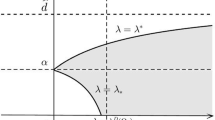Abstract
Motivated by the dynamics of neuronal responses, we analyze the dynamics of the FitzHugh–Nagumo slow–fast system with diffusion and coupling. In the case of diffusion, the system provides a canonical example of Turing–Hopf bifurcation. By analyzing the linear stability of the local equilibrium, the occurrence of Turing–Hopf bifurcation, Turing–Turing bifurcation and coupled Turing–Hopf bifurcation are obtained. The normal form associated with the Turing–Hopf bifurcation is obtained by using the procedure of Song for calculating the normal form of PDEs. Further, in the case of two coupled FitzHugh–Nagumo reaction–diffusion, the Turing–Hopf–Turing bifurcation occurs, and we also find the case about the spatial resonance of Turing–Turing bifurcation arising, and two kinds spatially steady-state solutions are found which are synchronous or anti-phased. Finally, sample numerical results are reported.


















Similar content being viewed by others
References
Hodgkin, A.L., Huxley, A.F.: Aquantitative description of membrane current and its application to conduction and excitation in nerve. J. Physiol. 117, 500–544 (1952)
FitzHugh, R.: Impulses and physiological states in theoretical models of nerve membrane. Biophys. J. 1(6), 445–466 (1961)
Nagumo, J., Arimoto, S., Yoshizawa, S.: An active pulse transmission line simulating nerve axon. Proc. IRE 50, 2061–2070 (1962)
Ambrosio, B., Aziz-Alaoui, M.A.: Synchronization and control of coupled reaction–diffusion systems of the FitzHugh–Nagumo type. Comput. Math. Appl. 64, 934–943 (2012)
Zhao, H., Huang, X., Zhang, X.: Turing instability and pattern formation of neural networks with reaction–diffusion terms. Nonlinear Dyn. 76, 115–124 (2014)
Song, Y., Zhang, T., Peng, Y.: Turing–Hopf bifurcation in the reaction–diffusion equations and its applications. Commun Nonlinear Sci. Numer. Simulat. 33, 229–258 (2016)
Yang, R., Song, Y.: Spatial resonance and Turing–Hopf bifurcations in the Gierer–Meinhardt model. Nonlinear Anal. Real World Appl. 31, 356–387 (2016)
Wei, M., Wu, J., Guo, G.: Steady state bifurcations for a glycolysis model in biochemical reaction. Nonlinear Anal. Real World Appl. 22, 155–175 (2015)
Rovinsky, A., Menzinger, M.: Interaction of Turing and Hopf bifurcations in chemical systems. Phys. Rev. A 46, 6315–6322 (1992)
Baurmann, M., Gross, T., Feudel, U.: Instabilities in spatially extended predator–prey systems: spatio-temporal patterns in the neighborhood of Turing–Hopf bifurcations. J. Theor Biol. 245, 220–229 (2007)
Yang, R., Zhang, C.: Dynamics in a diffusive modified Leslie–Gower predator–prey model with time delay and prey harvesting. Nonlinear Dyn. 87, 863–878 (2017)
Yang, R., Wei, J.: The effect of delay on a diffusive predator–prey system with modified Leslie–Gower functional response. Bull. Malasian Math. Soc. 40, 51–73 (2017)
Li, X., Jiang, W., Shi, J.: Hopf bifurcation and Turing instability in the reaction–diffusion Holling–Tanner predator-prey model. IMA J. Appl. Math. 78, 287–306 (2018)
Hoff, A., Santos, J.V., Manchein, C., Albuquerque, H.A.: Numerical bifurcation analysis of two coupled FitzHugh–Nagumo oscillators. Eur. Phys. J. B 87, 151 (2014)
Klaasen, G.A., Mitidieri, E.: Standing wave solutions for a system derived from the Fitzhugh–Nagumo equations for nerve conduction. Soc. Ind. Appl. Math. 17, 1 (1986)
Tuckwell, H.C., Miura, R.M.: A mathematical model for spreading cortical depression. Biophys. J. 23, 257–276 (1978)
Ambrosio, B., Aziz-Alaoui, M.A., Phan, V.L.E.: Large time behavior and synchronization of complex networks of reaction–diffusion systems of FitzHugh–Nagumo type. IMA J. Appl. Math. 84, 416–443 (2019)
Alexey, J.: Hyperbolic and non-hyperbolic chaos in a pair of coupled alternately excited FitzHugh–Nagumo systems. Commun. Nonlinear Sci. Numer. Simul. 23, 202–208 (2015)
Krupa, M., Touboul, J.D.: Complex oscillations in the delayed FitzHugh–Nagumo equation. J. Nonlinear Sci. 26, 43–81 (2016)
Castillo, J.A., Sánchez-Gardun̆o, F.: A Turing–Hopf bifurcation scenario for pattern formation on growing domains. Bull. Math. Biol. 78, 1410–1449 (2016)
Zheng, Q., Shen, J.: Pattern formation in the FitzHugh–Nagumo model. Comput. Math. Appl. 70, 1082–1097 (2015)
Labouriau, I.S., Murza, A.C.: Periodic solutions in anarray of coupled FitzHugh–Nagumo cells. J. Math. Anal. Appl. 412, 29–40 (2014)
Cattani, A.: FitzHugh–Nagumo equations with generalized diffusive coupling. Math. Biosci. Eng. 11, 203–215 (2014)
Ciszak, M., Euzzor, S., Arecchi, F.T., Meucci, R.: Experimental study of firing death in a network of chaotic FitzHugh–Nagumo neurons. Phys. Rev. E 87, 022919.1–022919.7 (2013)
Tehrani, N.F., Razvan, M.R.: Bifurcation structure of two coupled FHN neurons with delay. Math. Biosci. 270, 41–56 (2015)
Zemanová, L., Zhou, C., Kurths, J.: Structural and functional clusters of complex brain networks. Phys. D 224, 202–212 (2006)
Faria, T.: Normal forms and Hopf bifurcation for partial differential equations with delay. Trans. Am. Math. Soc. 352, 2217–2238 (2000)
Cai, Y., Zhang, C.: Hopf–Pitchfork bifurcation of coupled Van der Pol oscillator with delay. Nonlinear Anal. Model. Control 22, 598–613 (2017)
Author information
Authors and Affiliations
Corresponding author
Ethics declarations
Conflict of interest
The authors declare that they have no conflict of interest.
Additional information
Publisher's Note
Springer Nature remains neutral with regard to jurisdictional claims in published maps and institutional affiliations.
Rights and permissions
About this article
Cite this article
Zhang, C., Ke, A. & Zheng, B. Patterns of interaction of coupled reaction–diffusion systems of the FitzHugh–Nagumo type. Nonlinear Dyn 97, 1451–1476 (2019). https://doi.org/10.1007/s11071-019-05065-8
Received:
Accepted:
Published:
Issue Date:
DOI: https://doi.org/10.1007/s11071-019-05065-8




